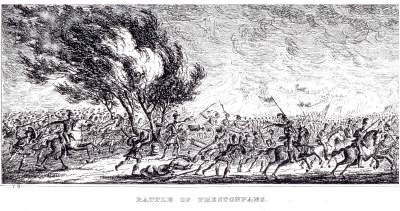When did the Battle of Prestonpans take place, and how long did it last?
Myths, Probable Reality and 'Theology'
.... of late some of the finest minds in the Trust have been pondering these questions and more for which there seem to be few definitive answers .... However ...
1. One fact we can get right from the outset is the date the battle took place. It was on what we would now call October 2nd under the Gregorian Calendar that we adopted in the United Kingdom in 1752. Until then, and obviously including 1745, the UK used the Julian Calendar which gave us the date we prefer to celebrate: September 21st.
2. A second confirmed fact is that the Highland army began its march through the Riggonhead Defile at around 3 am.
3. Cope reports that his dragoon outriders detected the Highland vanguard not much after 4 am. They reported straight back to him at which time, about 4.30 am, the single cannon was immediately fired to awaken the redcoat soldiers who then proceeded to wheel to the east. The Highland army was all through the marshes and in position north/ south by around 5 am just west of Seton Village.
4. We also know beyond doubt that the Highland charge began in half dark from its left flank, and that at some time during the affray John Home, the soon-to-be famous historian, reported that "the sun rose revealing the armies to each other". Records show that sunrise was due to occur at 6.19 am on September 21st 1745 [Julian Calendar].
click to enlarge the etching
This at first glance seems to show a charge by the dragoons that never took place at the south of the thorntree and west towards the Highland army. The single key forward movement by any dragoons at Prestonpans was towards the Duke of Perth's command on the Highlanders right flank well to the north of the thorntree [although the other squadrons did a brief walking advance at the outset]. But then again, it in truth seems that the artist has flipped the image and the dragoons are fleeing, pursued by Highlanders? One dragoon is glancing over his shoulder. Certainly the cannon is facing towards what look like Highlanders charging from the wrong direction! And is that the rising sun catching the upper branches of the thorntree perhaps and is that Tranent church on the hills behind?

5. None doubt that Colonel Gardiner died before noon at Tranent Manse to which, after being mortally wounded in battle beneath a thorntree close by the Waggonway, he had been carted by his servant dressed as a miller. A cart had to be found and brought, and it would have taken a good hour to make the journey. So Gardiner probably left the battlefield at about 8 am.
6. A further piece of evidence comes from Lord Drummore's account of the battle at the Commission of Inquiry into Cope's defeat. He seemed certain 'troop movements' were 'under way' by 5.15/ 5.30 am as he passed to the north of the battlefield.
7. As to how long the battle lasted, the answer was clearly 'not very long at all' since every raconteur and participant subsequently asserted it was an immediate rout. But it seems highly likely that they were all refering to the timeframe over which the two armies actually confronted oneanother in face to face conflict. As such, the time the Highlanders spent charging across the stubble of the cornfields from Seton Village and the time the redcoats spent running away towards the walls of Preston House, being chased and captured, would all be excluded. That full distance east/ west is nearly a mile.
8. Accordingly whilst talk of either 9 or 15 minutes actually in face to face in combat sounds possible, what is not possible is that the entire engagement from the start of the charge to the moment the Prince called Halt lasted either 9 or 15 minutes. That would undoubtedly have covered at least an hour or more. As such, Drummore could well be right that the redcoats realignments and the Highlanders charge were in motion about 5.15/ 5.30 am still allowing the sun to rise at 6.19 am during the face to face conflict and prior to the ensuing rout.
TO SUMMARISE EX CATHEDRA:
The Highlanders began moving west from their original lines by Seton Village at 5.15/ 5.30 am and engaged in face to face conflict at around 6.15 am, which lasted just some 10 - 15 minutes. The redcoats flight, pursued by the Highlanders with its occasional skirmishes, lasted up to a further hour before the Prince called a halt at about 7.30 am. Gardiner was safely evacuated from the battlefield by 8 am arriving at Tranent Manse at about 9.00 am. The attack on Warren Park and Cockenzie House to capture Cope's baggage train and his personal coach had beeen accomplished by 7.15 am.
And the battle took place on what today we know as October 2nd but by ancient custom and practice [at least since the 100th anniversary in 1845] we celebrate on Pope Julian's original calendar date of September 21st. QED.
Published Date: February 6th 2010
|





